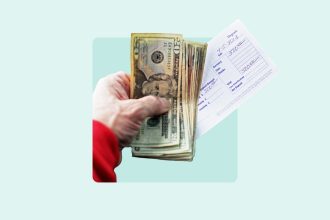Life throws curveballs. And often those curveballs mean you’re spending your hard-earned savings or you’re borrowing money instead. It can feel like a catch-22: Creating savings should help you avoid costly borrowing, but spending it equals losing it and going back to square one.
So what is a saver to do when paying for a financial emergency? Borrow cash or drain the savings account?
There’s a happy medium that you may not have heard of. It costs nothing, and it can get you ahead after a financial emergency. The best part is: You can get ahead in increasing your savings by an amount of your choosing. You just need to treat yourself like you’re a bank.
Here’s how to do it.
Why savings lets you act like a bank
This approach occurred to me after learning more about debt while working for a bank. I saw how much more things cost when people borrowed money. Then it hit me: If they can afford the payment, and they have sufficient savings, they could “borrow” it from themselves. Yes, that meant I’d send savings out the door, but it also meant I didn’t need to send a payment out the door — potentially for years — because of life’s curveballs.
My work to amass savings wasn’t in vain. Having capital made room for me to pay myself because it prevented a cost new payment for debt.
What if I had borrowed that money? I would then make a monthly payment until the balance is paid off. And, I would pay much more by the term of those payments than I initially borrowed.
Say, for example, I used my credit card to borrow $1,000 instead of using the $1,000 of my savings. Using Bankrate’s Credit Card Payoff Calculator for a credit card rate of 21 percent to pay off in 18 months, I’d send $65 per month for that term. That’s a total of $1,174 sent to the credit card company. You just paid $1,000 plus an additional 17.4 percent. Translation: you were already bummed about that financial emergency, and then you had to borrow, and then on top of that, whatever you needed now costs over 17 percent more!
I’d rather borrow $1,000 from myself and make that kind of return. And because I have savings, I could now. Here’s how to use this fact to rebuild and retain savings.
Savings as a self-loan through automatic transfers
Most people understand the idea of self-lending intellectually. And yet, many still borrow from a credit card company, even when they have the savings. We tend to treat lenders better than we treat ourselves by paying them a premium of 17.4 percent on top of what we borrow.
Now, borrowing $1,000 from myself means I pay my $1,000 in savings to cover a financial emergency. However, if I didn’t have those savings, I’d borrow $1,000, pay a 21 percent interest rate, and make a $65 monthly payment to a lender for 18 months.
If you can borrow that $1,000 from a lender, then it’s likely you can afford it, and if you can afford it, then you could pay yourself back, plus interest. So why not structure that repayment like it’s a loan?
You likely already have the tool in your online banking account to do it using the automatic transfers function listed prominently in the transfers section of your online banking.
Here are the steps:
- Visit Bankrate’s credit card payoff calculator and enter the amount you borrowed as well as your desired repayment timeframe. I generally want to repay myself within one to two years.
- Choose how much interest to charge yourself. The higher you set this, the more you experience the benefits of self-lending because, when you’re done paying yourself back, you’ll have earned the principal plus the interest.
- Now, go to your bank’s or credit union’s online banking site and set up a monthly transfer — to your savings account at that institution or at another institution — for the payment amount calculated by the credit card calculator. Set the expiration date based on the repayment calculator as well.
You can pick the amount (and the rate), the cadence, and the destination for the transfer. The technology does the rest.
It’s harder to decide what you’re going to charge yourself because we’re prone to cheat ourselves of interest more easily than choosing not to pay it to a lender. Imagine you’re Mr. Potter, the villainous robber baron from Frank Capra’s film It’s a Wonderful Life. What rate would he charge you? You know the answer: He’d charge you as much as possible.
I had issues with overdoing this when I first started, so be sure to experiment with the number of months to pay off and the rate in the repayment calculator until it aligns with your budget. My recommendation: Make it hurt as much as if it were going to pay a lender so that you’re rebuilding your savings to cover future (and even larger) emergencies.
Applying a “self-loan” method to large purchases
My wife and I use this method today, even when buying vehicles. Obviously, we didn’t start that way and had to save for years before reaching that point.
I’ve covered how to accumulate large amounts of cash in previous articles. One other approach my wife and I have found effective when saving more is adopting a ‘cancel everything’ mindset — audit our statements for cryptic deductions, cancel unwanted subscriptions and set up our finances to prevent losing track of things easily.
— Matthew Doffing | Bankrate consumer banking columnist
A few years ago, we had to buy a Honda Odyssey, which cost us about $16,000. We used cash from our savings instead of borrowing. A loan would’ve required a monthly payment of $309 at 6 percent interest for 60 months. We would’ve spent $18,559 for the van once we accounted for interest.
Because we had the capacity in our income at the time, we decided to more than double that payment back to ourselves to about $700. In just over 22 months, we had repaid the $16,000 we borrowed from ourselves, and with the interest we had re-saved, more than $18,000.
You may not be able to pay more than a repayment calculator indicates, and that’s fine. The goal here is to use technology to enhance the value of your own capital by treating it as if it’s someone else’s, such as a credit card lender. The more you charge yourself, the greater the benefit to you once you’ve paid yourself back in full.
Bottom line
Remember when you wished you had savings? I remember it. I just wanted to avoid borrowing. Then we had an emergency, and we avoided borrowing, but our savings had flown out the door.
So what did saving get me? Working for a bank showed me the answer: Capital. And having my own capital gave me the option not to borrow. And that allowed me room in our budget to pay myself. It wasn’t going to be a hard slog to re-save the money; I just needed to treat my savings as though I owed it to myself.
Treating your savings like a self-loan sets it on a path to rebound automatically, and once it does, you’ll have more savings.
When life throws you a curveball, and you have savings, don’t borrow from a bank if you can help it. Instead, pretend you’re “Mr. Potter” and borrow your own capital. The pain of borrowing then comes with the benefit of being the lender, whereas before, if you borrowed, you’d pay for the debt with no such benefit.
Why we ask for feedback
Your feedback helps us improve our content and services. It takes less than a minute to
complete.
Your responses are anonymous and will only be used for improving our website.
Help us improve our content
Read the full article here
















